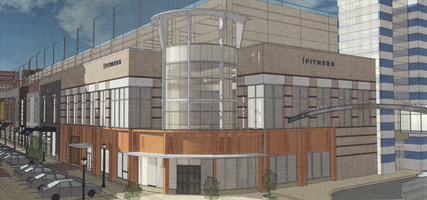|
General Building Data |
Building Name |
Bakery Square at East Side; Building 1 |
Location and Site |
Penn Avenue and East Liberty Boulevard, Pittsburgh, Pennsylvania |
Building Occupants |
| Signed Tenants |
Urban Active |
| Proposed Tenants |
Houlihan's, Ann Taylor Loft, and Anthropologie |
|
Occupancy Type |
Retail, Fitness, and Parking |
Size |
378,000 Square Feet |
Number of Stories |
6 Above Grade |
Owner/ Developer |
| Bakery Square Holdings, L.P. |
|
|
CM at Risk |
|
Architect |
|
Civil Engineer |
| Hampton Technical Associates, Inc. |
|
|
Elevator Consultant |
| Lerch Bates & Associates, Inc. |
|
|
Signage Consultant |
|
Traffic Consultant |
| David E. Wooster and Assoc., Inc. |
|
|
Parking Consultant |
| Walker Parking Consultants |
|
|
Start Date |
March 17, 2008 |
Expected End Date |
March 3, 2009 |
Cost |
The cost for the parking garage section and the core and shell of the retail space of Building 1 is set at $24 Million. The contract type is a Cost Plus a Fee with a GMP. A fixed fee of 4% with a contingency has been established. The contingency will be divided 75% - 25% to the owner and the construction manager respectively. |
Delivery Method |
Construction Manager at Risk |
|
Architecture |
Architecture |
The building is designed primarily around a precast concrete structure. The functional components of the building consist of retail and restaurant spaces on the ground floor of the central and east portion of the structure. Above these areas is an open two story shell that is designed to accommodate a fitness center. Inside the fitness center, an elevated cast-in-place swimming pool is located on the second floor, and a third floor structural steel mezzanine level will be constructed under a separate contract. An underpass separates the central and west portions of the building from ground level up to the third floor. The parking garage comprises the entire west end of the structure, and it also bridges over to the central and east portions starting at level four. The parking garage continues to the top of the building located at level six. |
Codes |
International Building Code (IBC) 2006
National Electric Code (NEC) 2002
International Mechanical Code (IMC) 2003 |
Zoning |
A-2 |
Assembly (Restaurant Use) |
A-3 |
Assembly (Recreational Use) |
M |
Mercantile - Retail Space |
S-2 |
Open Parking Garage |
|
Building Envelope |
The exterior walls are constructed in several different ways. The envelope for the retail space is however not in this contract. Therefore, stud framing with ¾” exterior grade plywood will be used for a temporary wall. Locations above the retail call for 6” metal studs with batt insulation and a 2 ½” layer of rigid insulation, but the exterior finishes have not been chosen and will be installed by the retail tenants. Areas around the stairwell are comprised of precast concrete panels with a fabric membrane, an air space, and either a cast stone or brick veneer. All other exterior walls in the closed portion of the building will be constructed from 6” metal studs with batt insulation, a vapor barrier, 1” rigid insulation, and a block or brick veneer. The parking garage structure uses precast concrete spandrel panels as exterior walls.
The parking garage is open air and has no roofing system. The roofing for the assembly varies between two types of construction. Areas that are outside of the parking garage footprint are covered by a high-reflective TPO roofing membrane over a tapered rigid insulation substrate. Areas that are under the parking garage have a split slab system for roofing purposes. This design is constructed by placing a waterproofing membrane, 4” rigid insulation, and a 4” concrete topping on the fourth floor’s precast double tees. Flexible rubber joints and joint sealants are used to create a water barrier where joints occur between the precast tees. |
| |
Primary Engineering Systems |
Construction |
Walnut Capital chose to hire P.J. Dick for Building 1 as a CM at Risk with a lump sum contract for $24 Million. P.J. Dick is also hired to renovate an existing building and construct three other buildings on site at Bakery Square. This has allowed P.J. Dick to structure their General Conditions costs into a very efficient package.
|
Electrical |
Two 480/277 V, 3 phase main feeders supply the electricity for Building 1. A 2,000 amp line is used to feed the retail and garage portion of the building, while a 2500 amp line is dedicated to the fitness center.
A 100 KW backup generator provides temporary power to the elevators, emergency lighting, and emergency systems located in the building should the power supply be disrupted.
|
Lighting |
Fluorescent garage fixtures with cold weather ballasts are the most prevalent fixtures used in Building 1. The garage lighting is attached to 277 volt circuits, equipped with bird shrouds, and ceiling mounted throughout the entire garage.
Pole mounted metal halide fixtures and compact fluorescent flood lights are attached atop of 20 feet aluminum poles for lighting the top floor of the garage.
The interior portions of the building are lit using TF series fluorescent strip lighting wired to 120 volt circuits. These ceiling mounted fixtures use electronic ballasts for startup and an aperture reflector is used to provide 15% up-lighting. |
Mechanical |
There are multiple mechanical systems in place in this building due to the varying functionalities of the spaces. In the garage portion of the building, electrical wall heaters, cabinet unit heaters, electric duct coils, and packaged terminal AC (PTAC) units are placed in the lobbies and garage office areas. Two rooftop units are also used to cool the elevator shafts.
The restaurant, retail spaces, and the fitness center each have their own separate forced air roof top units for heating and cooling purposes, but are not included in this contract. These units will be located on the low roofs located directly above level 1 and level 3.
|
Structural |
Building 1 structural composition includes cast-in-place foundations, a structural steel mezzanine, and a precast concrete structure.
The foundation system is comprised of 18 inch auger cast piles that are topped with concrete pilecaps ranging in size from 8’-0” x 4’-6” x 3’-6” pads to the largest type that are 15’-0” x 10’-7” x 4’-7”. The grade beams are usually 16x36 inches in size or 24x40 inches, with the latter being the largest.
Wide flanged members are used to support a mezzanine level located inside the fitness center. The floor is designed to suspend from the precast decks above. A W33x354 beam is the largest member that will be erected for Building 1. A 5 ½” composite slab is specified for this hanging mezzanine level.
The majority of the building is designed for precast concrete. 32” deep precast double tees are used for the parking garage structure and to enclose in the retail and fitness center. These double tees are 12 feet wide and span 62 feet. The columns for the structure span three floors. Outside corner columns are as large as 54” square while perimeter and inside columns are smaller. |
| |
Engineering Support Systems |
Fire Protection |
Inside the parking garage, manual dry standpipes in the stairwells are designated for fire protection. All other areas will fulfill fire suppression requirements through the use of sprinklers.
Since the building is constructed from precast concrete, no fireproofing is needed for the structure. At the limited places where steel is used, it will be covered in an intumescent mastic fireproofing paint. Also, fire barriers are created with the use of fire rated walls between such areas as the parking garage, stairwells, the fitness center, and retail spaces.
|
Transportation |
There are four electric traction elevators within Building 1. All four must meet a capacity of 3500 lb, have a speed of 350 FPM, and be rated for Passenger Class A and Service Class A loading. Cars one and two have five stops, while cars three and four service seven levels.
|
Telecommunications |
Electric metallic tubing is being run to each area of retail space, restaurant space, and fitness center for telecommunication and data purposes. Since these areas will be finished through a fit-out contract, the requirements for wiring are not known at this time. |
| Facility Management |
A Parking Access and Revenue Control System (PARCS) is to be installed to manage the parking garage. This management system is a network composed of a server, subsystem computers, and workstations capable of providing on-line monitoring and control of PARCS. |

